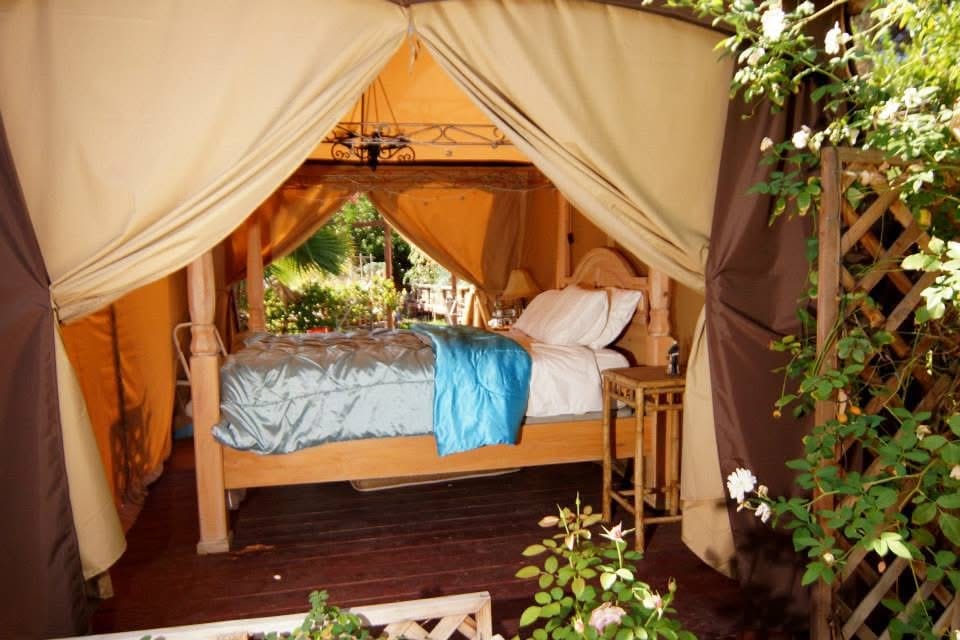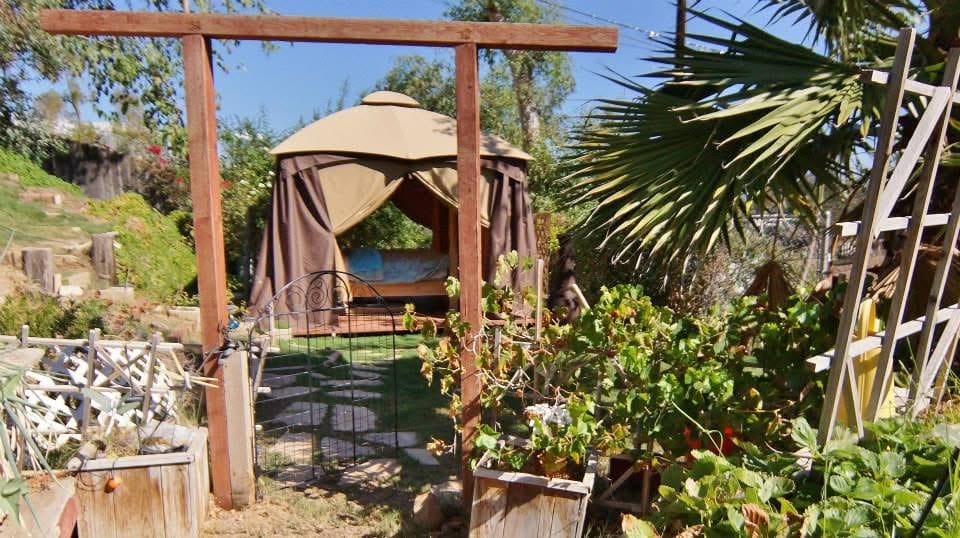Backyard Glamping Gazebo With A Bed To Sleep Under The Stars
DIY Projects Decor Outdoor Living

There’s a particular kind of magic that happens in a garden after dark. The air cools, the wind softens, and the plants that spent all day soaking up the sun seem to breathe out. I’ve always been the type to linger outside long past sunset, just listening to the crickets and catching the faint perfume of night-blooming flowers. But a few years ago, I decided to take it up a notch and create what I now call my backyard glamping gazebo. Yes, it has a bed. In fact, it has evolved into more of a backyard bedroom. Yes, I’ve slept out there more times than I can count. And yes, I’ve woken up covered in mosquito bites, but only ONCE — I learned that lesson early.
This is the story of how I pieced it together, mistakes and all, and why I think every garden lover should try spending the night in their beautiful backyard.

Why Sleep Outside in the Garden?
For one, it’s a lot closer than camping in the woods. You can still pad into the kitchen in your slippers for a midnight snack. But more than that, it changes the way you connect with your garden. You hear the shift from day to night — the bees clocking out, the moths clocking in. You notice the subtle floral perfumes that only release after dark, like evening primrose or night phlox. And if you’re like me, you start to see your garden as more than just a daytime project — it becomes part of your home’s living rhythm.
Plus, there’s nothing like waking up to birds singing, the moring golden rays and a soft breeze instead of an alarm clock.

The Gazebo Frame: Shelter With a View
When I first started dreaming about sleeping outdoors, I thought a simple tent would do the trick. That lasted exactly one night. Tents hold in heat, they hold in condensation, and they hold in every bit of your breath — not exactly what I wanted on a sticky July night.
So, I went with a freestanding gazebo frame. Mine’s about 12 by 10 feet, with a peaked roof to shed rain and just enough structure to feel solid in a storm. You can find them at most big box stores or second-hand online. If you get one, make sure the roof fabric is UV-resistant and that the frame can handle a bit of wind. Nothing kills the mood like chasing your gazebo down the street at midnight. Metal roofs also work well, or no roof at all, but then make sure you cover yourself with your favorite bug spray or have lots of calendula plants surrounding your bed.
Keeping the Bugs Out
No matter how romantic “sleeping under the stars” sounds, it’s not worth donating a pint of blood to the local mosquito, or worse, spider population. There are a few tricks. One is to build a deck to get your bed off the ground. Next is to invest in good-quality mosquito netting that wraps around the gazebo and seals or zips at the bottom.
I used net panels that overlap with magnets sewn in at the seams. You can actually buy gazebos and tents that already have the nets. Just make sure the floor and walls of your chosen closure will keep out the creepy crawlies. If you want extra insurance, tuck the base of the netting under a strip of outdoor rug or a few lengths of garden edging. If netting works on safari in Africa, it should keep beetles and crawling critters from joining you at 3 a.m.
Choosing the Right Bed
I’ve tried it all: hammock, camp cot, inflatable mattress, and graduated to a small daybed frame with a real mattress wrapped in a waterproof cover. I have even gone so far as to buy an entire queen-size canopy bedroom set with frame, dresser, and side table at a garage sale. That last setup has been the winner and even became the favorite guest room when friends would come to visit. The bed is high enough off the ground to stay cool and dry, and the mattress cover means dew is no big deal. I keep a stack of light cotton blankets handy — perfect for layering as the night cools.
If you really want to feel spoiled, add a couple of throw pillows and a quilt that’s soft enough to make you forget you’re outdoors. The point is to be comfortable enough to drift off naturally, not toss and turn until sunrise.
Adding Fragrance and Ambience
If you’ve never smelled a night-blooming jasmine in full swing, you’re missing one of gardening’s most underrated experiences. There’s something about those velvety white blossoms opening in the dark that feels luxurious. Plant them near your gazebo, or try nicotiana (flowering tobacco), moonflower, or four o’clocks. They’ll scent the air without overpowering it.
I also added a few strands of solar-powered fairy lights inside the roof beams. No, seriously, they charge during the day and give a soft glow at night — not really enough light to read by, but not enough to ruin your view of the stars or look out into your garden.

Practical Little Comforts
A few details I learned to add over time:
- A side table for a thermos of tea, a flashlight, and maybe a good book.
- An outdoor rug under the bed to keep bare feet from feeling cold, damp grass first thing in the morning.
- A battery-powered fan for those hot, still nights, and if the errant mosquito comes in, they hate the wind.
- A blanket box to stash bedding if it starts to drizzle while you’re at work.
These small touches make the difference between “A romantic idea” versus “A real habit you look forward to.”
Mistakes I’ve Made (So You Don’t Have To)
- Underestimating the dew — it’s incredible how wet things can get just from the night air. Waterproof covers are your friend.
- Placing the gazebo in a low spot — moisture collects there, and your bed will feel clammy.
- Forgetting to zip up the netting before dark — nothing like discovering a confused moth dive-bombing your forehead at 2 a.m.
- Too close to bright lights — porch lights or streetlights will ruin the natural night vibe.
Why It’s Worth It
Every time I sleep in the garden, I remember why I started gardening in the first place. It’s not just about the tomatoes, or the compost, or the neat rows of lettuce. It’s about being part of the living, breathing world — even if it’s just for a night at a time. You hear the leaves rustle in a way you don’t notice in the daytime. You catch the scent of flowers that are invisible in the dark. And you realize that this patch of earth you’ve tended is more than a hobby — it’s a little piece of the planet you get to call home.
Quick FAQ for Backyard Glamping
Do I need a permit to set up a gazebo in my yard?
In most cases, small, temporary gazebos don’t require permits. My personal favorite is the canvas type with a metal frame, and many of them come with curtains and netting. Check your local zoning rules to be sure.
What’s the best way to keep bugs out?
Fully enclosed mosquito netting with no gaps, plus tucking in the edges to block crawlers. I am also guilty of using natural bug sprays around the outside edges of the gazebo.
Will my mattress get ruined outdoors?
Use a waterproof mattress cover and keep bedding stored in a weatherproof box when not in use.
What are the best flowers for scent at night?
Night-blooming jasmine, moonflower, nicotiana, evening primrose, and four o’clocks are all great choices.
Can I use candles for ambience?
Skip open flames inside the gazebo. Try battery-operated lanterns or solar lights instead, but make sure to pick a soft glow and not a fluorescent colored bulb. Outside the gazebo, consider a chiminea for a small wood fire to enjoy that campfire smell.
If you’re on the fence about trying it, start small. One summer evening, make up a cozy bed, zip up the netting, and see what it’s like to fall asleep with the smell of jasmine in the air and the sound of leaves whispering overhead. It might just become your favorite “room” in the house — and it doesn’t even have a roof over it.
Share this post
All categories
More From The Garden
Disclosure: This post may contain affiliate links. That means if you click and buy, The Bright Garden may earn a small commission, at no extra cost to you. We only recommend products we’ve vetted and believe will benefit our readers.












